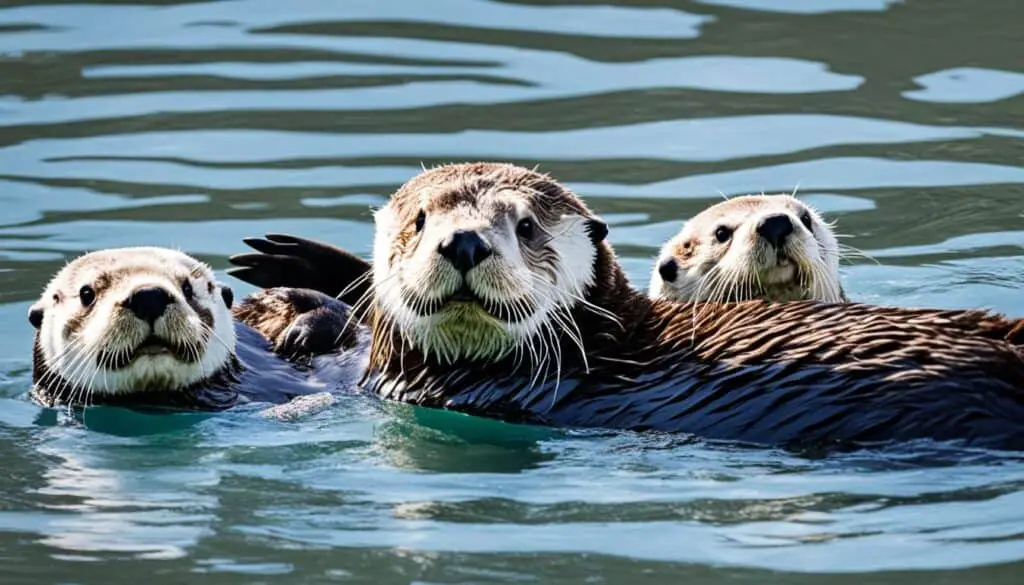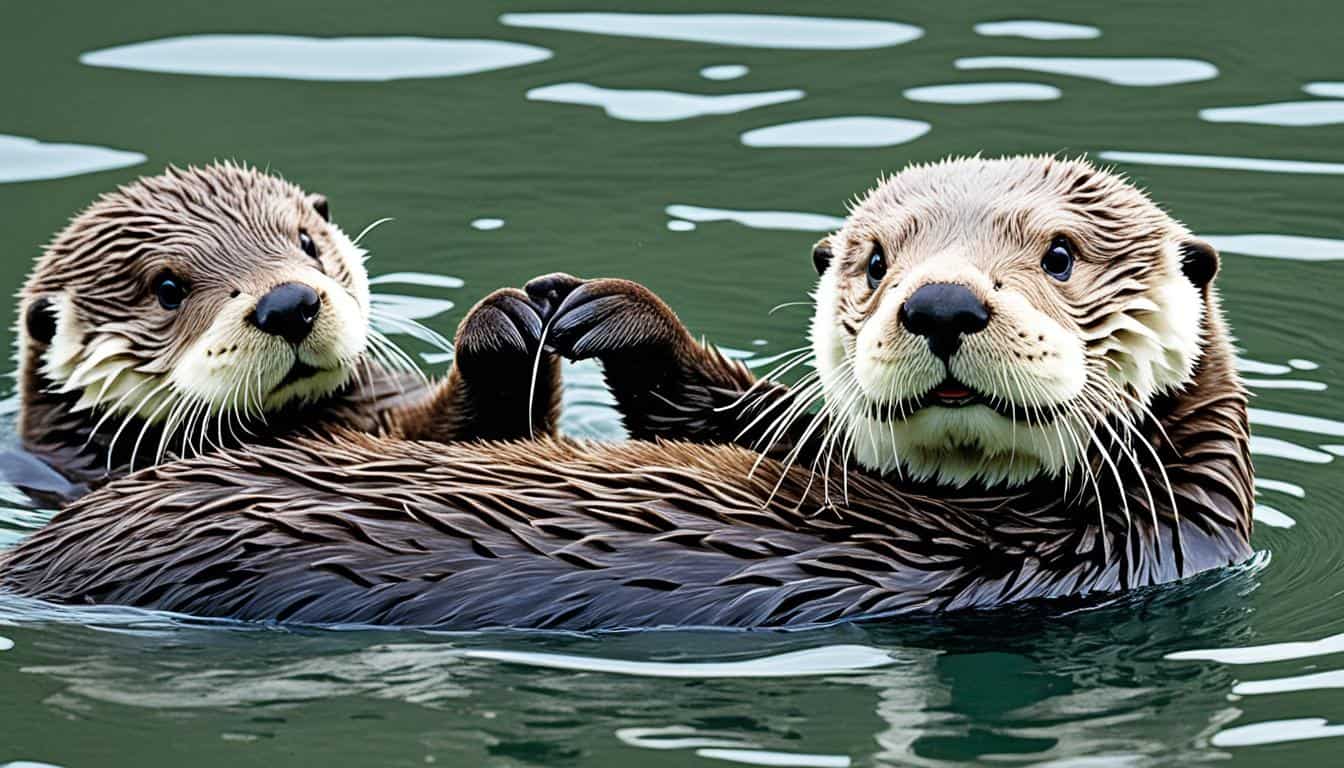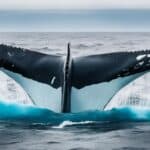Sea otters are fascinating marine mammals, and knowing how long they live is important. They usually live between 10 to 15 years in the wild. Some sea otters in captivity have even lived over 20 years. Their lifespan depends on health, the environment, and human actions.
These factors greatly impact their ability to survive and reproduce. By understanding how long sea otters live, we see why it’s crucial to protect them. This knowledge helps us know how to keep this vulnerable species safe.
Understanding the Sea Otter Lifespan
The life of a sea otter is shaped by many things, like health, the environment, and human actions. Knowing about these factors helps us understand how long sea otters live. Sea otters often face big challenges early on, with many young ones not making it.
This shows how important their home is and why we need to protect it. In the wild, sea otters deal with threats like predators, diseases, and losing their homes. Keeping an eye on their numbers is key to helping them survive.
Learning about sea otters’ lives helps us see why they’re important and the hurdles they face. We must protect their homes and spread the word about how they survive. This will help them live longer in the wild.
How long do sea otters live?
Sea otters live different lengths of time based on where they are. Their average life in the wild and in captivity changes due to many things. These include what they eat, their health care, and their environment.
Average Lifespan in the Wild
In the wild, male sea otters usually live for 10 to 15 years. Females often live longer, up to 20 years. Things like being hunted and getting sick can affect their sea otter years. For instance, the California sea otter has faced many health issues. This has made their survival harder in the wild.
Longevity in Captivity
Sea otters in zoos live much longer than those in the wild. Many live over 20 years in captivity. This is because they have a steady diet, no predators, and regular doctor visits. Zoos help them live longer by managing their health and reducing risks like getting sick or not having enough food.
| Environment | Average Lifespan | Factors Impacting Lifespan |
|---|---|---|
| Wild | 10-20 years | Predation, disease, environmental stresses |
| Captivity | 20+ years | Controlled diet, absence of predators, veterinary care |
Factors Influencing Sea Otter Age
Sea otter aging is influenced by many factors, affecting their health and survival. Health risks and environmental conditions play a big role. These factors can greatly impact their lifespan and life quality.
Health and Disease
Sea otters face many health risks that can cut their lives short. They are prone to diseases such as:
- Kidney stones
- Tooth decay
- Parasitic infections
Toxoplasma gondii is a big threat, causing severe brain damage. Keeping a close eye on their health is key for conservation efforts. This helps improve sea otter aging and their overall well-being.
Environmental Impacts
Environmental factors like habitat loss, pollution, and climate change affect sea otters a lot. For example, oil spills can ruin their fur, making them lose heat and increasing death rates.
Bad environmental conditions also make it harder for them to find food. It’s important to understand these impacts to help sea otters and protect the ecosystem.
| Health Risk | Description | Impact on Aging |
|---|---|---|
| Kidney Stones | Formation of mineral deposits in the kidneys | Can lead to kidney failure if uncontrolled |
| Tooth Decay | Deterioration of teeth affecting diet | Hinders ability to consume necessary food |
| Parasitic Infections | Infections from organisms like Toxoplasma gondii | Can cause severe neurological damage |
| Oil Spills | Contamination of habitat and fur | Increases risk of hypothermia and mortality |
Life Cycle and Behavior of Sea Otters
Sea otters go through important growth stages that affect their survival. These stages are key to understanding sea otter biology.
Growth Stages
Sea otter pups start life at about five pounds, needing their mothers for food and safety. They stay with their mothers for a year, learning vital skills. Important growth points include:
- Pups start diving and hunting at two months old.
- They become independent after about a year, learning how to survive.
- During these stages, they grow physically and learn behaviors that help them live in different places.
Mating and Reproductive Behaviors
Female sea otters can have babies at three years old, while males are ready at five or six. Mating has special traits of sea otter biology:
- They delay implanting the fertilized egg, adjusting to their environment.
- Usually, one pup is born, but sometimes twins happen, showing how rare it is.
- Parents play a big role, teaching their pups how to find food and dive.
Comparative Lifespan: Sea Otters vs. Other Marine Mammals
Sea otters live shorter lives than many other marine mammals. For example, harbor seals can live up to 30 years. Some whales, like baleen whales, can live over 70 years. This shows how unique sea otters are and why we should think about their role in nature and how to protect them.
To understand sea otters’ lives, we must look at how they compare to others. Things like being hunted, losing their homes, and getting sick can cut their lives short. This means their numbers can change quickly in different places.
Here’s a brief overview of the lifespan comparison with other marine mammals:
| Marine Mammal | Average Lifespan |
|---|---|
| Sea Otter | 15-20 years |
| Harbor Seal | 20-30 years |
| Gray Whale | 50-70 years |
| Bottlenose Dolphin | 40-60 years |
This comparison shows how important sea otters are in nature. It also points out the need for efforts to save these important sea creatures.
Sea Otter Biology Related to Aging
Sea otters are fascinating creatures that help us understand aging. They have unique physical traits that help them live well in the water. These traits are key to their long lives.
Physical Characteristics
Sea otters have dense fur that keeps them warm in cold water. Their fur is the thickest of any animal, with up to a million hairs per square inch. Adult males can weigh about 65 pounds and reach four feet in length. Females are smaller.
This size difference shows how males and females are different, which affects their aging.
Adaptations for Survival
Sea otters adapt to aging challenges with special skills. They use tools like rocks to open shells, showing their smart hunting ways. Their webbed feet and strong tail make them agile in the water. This helps them hunt and avoid predators.
These skills not only help them survive but also keep their ecosystems healthy. They are important for the environment.

Threats to Sea Otter Longevity
Sea otters face many threats that affect their survival. Overhunting for their fur once greatly reduced their numbers. This not only harmed individual otters but also hurt the balance of marine life.
Now, while laws protect them, sea otters still struggle with many challenges. Oil spills are a big threat. These spills can harm their homes and lead to serious health problems or death.
Coastal pollution also hurts their food supply. This leads to a decline in the marine life that sea otters depend on. Habitat destruction from urban growth and climate change adds to the danger. It affects their homes and places to find food.
Sea otters are key to a healthy ocean. Protecting their homes and reducing human impact is crucial for their future. We need awareness and good conservation plans to help sea otters. This will ensure they thrive for many years to come.
FAQ
How long do sea otters live?
Sea otters in the wild usually live between 10 to 15 years. Some can live more than 20 years in places like zoos.
What factors influence the lifespan of sea otters?
Many things can affect how long sea otters live. This includes health issues, the environment, and human actions that can help or hurt them.
How does health affect sea otter longevity?
Sea otters often face health problems like diseases and parasites. These can really shorten their lives, especially when they are young.
How do sea otters age compared to other marine mammals?
Sea otters don’t live as long as some other sea creatures. For instance, harbor seals can live up to 30 years, and some whales can live over 70 years.
What is the average life expectancy of sea otters in captivity?
In places like zoos, sea otters can live a lot longer. They often live more than 20 years because they have safe food and no predators.
What are the growth stages of sea otters?
Sea otter pups are born heavy, up to five pounds. They depend on their mothers for food and safety at first. They start learning how to survive after about a year.
What are the threats to sea otter survival?
Sea otters are threatened by things like damaged homes, pollution, and human actions. Hunting and oil spills are big dangers for them.
What adaptations help sea otters survive as they age?
Sea otters have special features like thick fur and webbed feet. They also use tools, which helps them survive as they get older.







